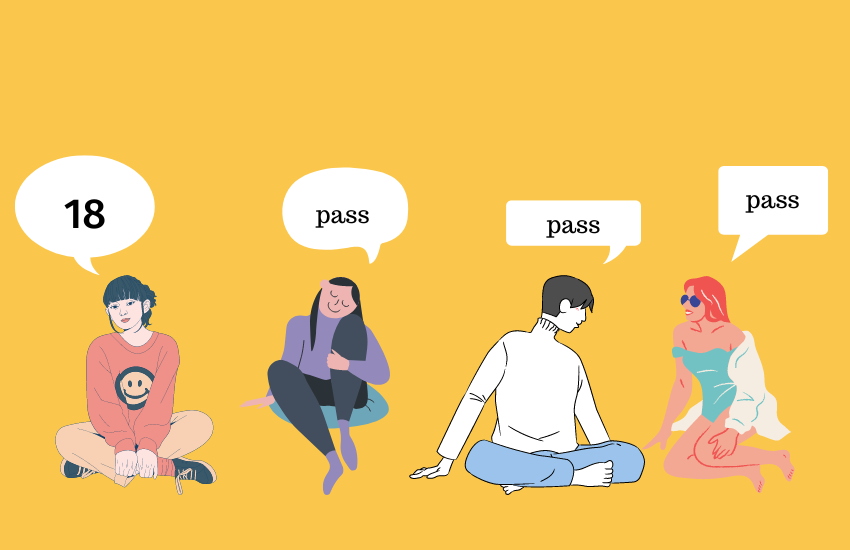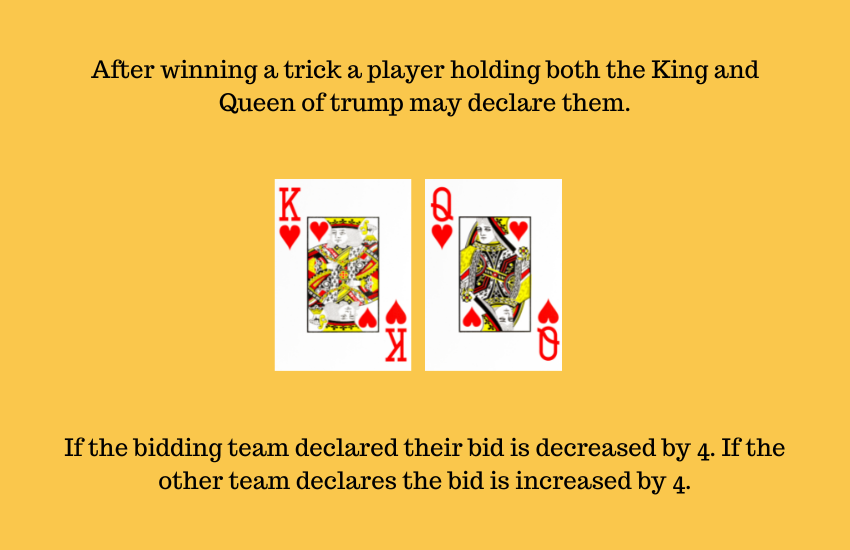
OBJECTIVE OF TWENTY-NINE: Wins tricks with valuable cards played.
NUMBER OF PLAYERS: 4 players (two partnerships)
NUMBER OF CARDS: 32 cards (8 cards per suit)
RANK OF CARDS: J, 9, A, 10, K, Q, 8, 7
TYPE OF GAME: Trick-Taking
AUDIENCE: Adult
INTRODUCTION TO TWENTY-NINE
Twenty-Nine is a South Asian trick-taking card game. It is believed that this game is a descendant of a family of European games called Jass games. The principles of the game were imported along with Dutch traders.
The Cards
Twenty-Nine is generally a four-player game with two partnerships. Partners face each other during play. The game utilizes only 32 cards of a standard 52-card deck, 8 cards per suit. The cards rank as follows: J (high), 9, A, 10, K, Q, 8, and 7 (low).
The objective of Twenty-Nine is to win tricks that have valuable cards in them. A trick is a hand in a trick-taking game. Each player plays a single card in a trick. The winner of the trick, the player with the highest value card, takes the cards.
Cards values are as follows:
Jacks: 3 points
Nines: 2 points
Aces: 1 point
Tens: 1 point
K, Q, 8, 7: 0 points
This gives a total of 28 points. Some variations have a total of 29 points for the last trick, which is how it received its namesake. However, the game is generally not played that way and still retains the name.
The game is traditionally played with the 2s, 3s, 4s, and 5s being used as trump indicators. Each player receives cards from each suit. Sometimes, the 6s are used to keep score. A set of partners each receives a red and black six.
THE DEAL & THE BIDDING
The deal and game play pass to the left. The dealer shuffles the deck and the player to their right cuts it. Each player receives four cards, one at a time, face-down.
Depending on the cards in hand, players place bids for electing trumps. A bid is a number that represents the number of tricks that a person believes their partnership can make. The highest bidder wins. The bid starts with the player to the left of the dealer and moves left. Players can raise the bid or pass. This continues until 3 players pass in a row. The minimum bid is 15 and the maximum is 28. If everyone passes the dealer must make a forced bid of 15, this also ends the bidding.

The winner of the bidding selects the trump suit. The 2s and 5s not being used are arranged so that the trump suit the bidder chose is at the bottom.
The dealer passes each player another 4 cards. Each player now has 8 cards.
THE PLAY
The first trick starts with the player to the left of the dealer. Each player must follow suit if they can. At this point, the trump suit is unknown to all other players. The first player who is unable to follow suit is required to ask the bidder what the trump suit is and they must show the trump suit to everyone. However, if the bidder is the first player who is unable to follow suit they must declare to everyone what the trump suit is. Once the trump is declared the highest value card from that suit played wins the trick, if no trump card is played then it is the highest value card of the suit led.
If you cannot follow suit, you can play a trump, but you are not required to.
After trumps have been declared, players with a King and Queen in the hand of the suit may announce they have “Royals” or a “Pair.” These can only be revealed after winning a trick. You may not claim them if they have been used in a trick.

In the event, that the bidder or their partner announces they have a Pair, their bid is reduced by four, as long as their bid remains above the 15-point minimum. However, if the other partner has the Pair it increases the bid by 4, as long as it doesn’t exceed 28.
THE SCORING
After all 8 tricks have been taken, the partnerships total the value of the cards they have won. The winners of the last trick add an additional point to their total. If the bidding partnership fulfilled their contract by taking the required number of tricks they win a single game point. If not, they lose a game point. The other set of partners’ scores remains constant.
The red and black sixes are used for keeping the score. The red six (nali or red chaka) displays the positive score, deeding on the number of pips revealed. The black six (kala or black chaka) displays the negative score with the number of pips it has revealed. At the start, each partnership has no pips showing. Pips are revealed as players lose or gain points. The game can end in one of two ways: one team has +6 points or one team has -6 points.
FREQUENTLY ASKED QUESTIONS
How do you win 29 card game?
To win Twenty-Nine players need their team to reach +6, or the opposing team to reach -6.
Why is the game named Twenty-nine?
The name of the game comes from the number of points, although there are only 28 points to win in the game. In some variations, that are no longer very common, an additional point for the last trick is given. Although this ruling is no longer used in common play the naming stuck.
What happens if you cannot follow suit.
The game is played so that players, except the bidder, do not know what the trump suit is at the start of the game. If a player is unable to follow suit and it is the first time this has occurred the player must ask the bidder what the trump suit is, or if it is the bidder the trump suit must be declared. When a player cannot follow suit they may choose to play a trump but are not required to. If they wish not to play a trump or are unable to they may play any card.
- Comprehensive Guide to the Board Game Go (weiqi, baduk) - January 23, 2024
- Are Creative Suites Changing Gaming - October 30, 2023
- Crowning the Kings of Solitaire: GameRules Recognizes Solitaired and MobilityWare as top Solitaire Games - October 20, 2023